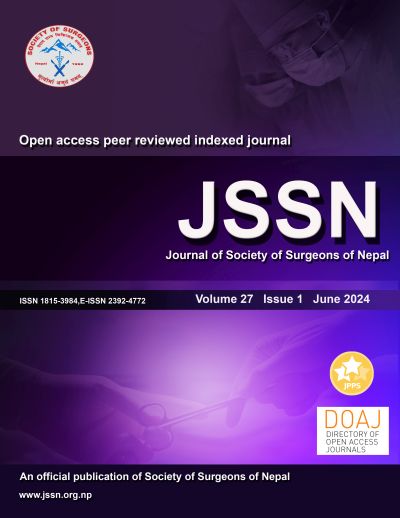Presentation and outcome of Gastric Cancer at a Tertiary Care Center
DOI:
https://doi.org/10.3126/jssn.v27i1.71273Keywords:
Chemotherapy, Gastrectomy, Gastric cancer, LymphadenectomyAbstract
Introduction: Gastric cancer is the fifth most common cancer globally and the fourth leading cause of cancer-related deaths. Early-stage disease can be managed with endoscopic therapy or surgery, while advanced gastric cancer requires a multimodal treatment approach, including extensive lymphadenectomy. This study aims to evaluate the clinicodemographic profile and treatment outcomes of gastric cancer patients and to establish an effective therapeutic strategy.
Methods: This retrospective descriptive cross-sectional study was conducted in the Department of Surgery at Shree Birendra Hospital. It included patients with gastric malignancies who had complete medical records. Data on patient history, AJCC staging, operative details, and postoperative findings were analyzed. Surgical choices were based on the clinical indication in each case. Clinicopathological characteristics and surgical outcomes were compared across tumor stages. Data were analyzed using Statistical Package for Social Sciences (SPSS) version 24.
Results: The study included 90 patients (62 males, 28 females) aged between 23 and 82 years. The most common clinical presentations were abdominal pain (58%), gastric outlet obstruction (18%), lump (5%), anemia (5%), and peritonitis (4%). Adenocarcinoma was the predominant histological type (87.78%). Curative surgery was performed on 73 patients (81.11%), while 17 patients (18.89%) underwent palliative procedures. Morbidity occurred in 16 patients (17.7%), primarily due to chest complications and sepsis, and mortality was recorded in 5 patients (5.5%).
Conclusion: This study highlights the predominance of locally advanced gastric cancer in males, with distal gastric cancer and well-differentiated adenocarcinoma being the most common. Chest complications and sepsis were the leading causes of morbidity and mortality. No patients received perioperative chemotherapy, underscoring the need for updated treatment protocols to improve outcomes.
Downloads
Downloads
Published
How to Cite
Issue
Section
License
Copyright (c) 2024 The Author(s)

This work is licensed under a Creative Commons Attribution 4.0 International License.




